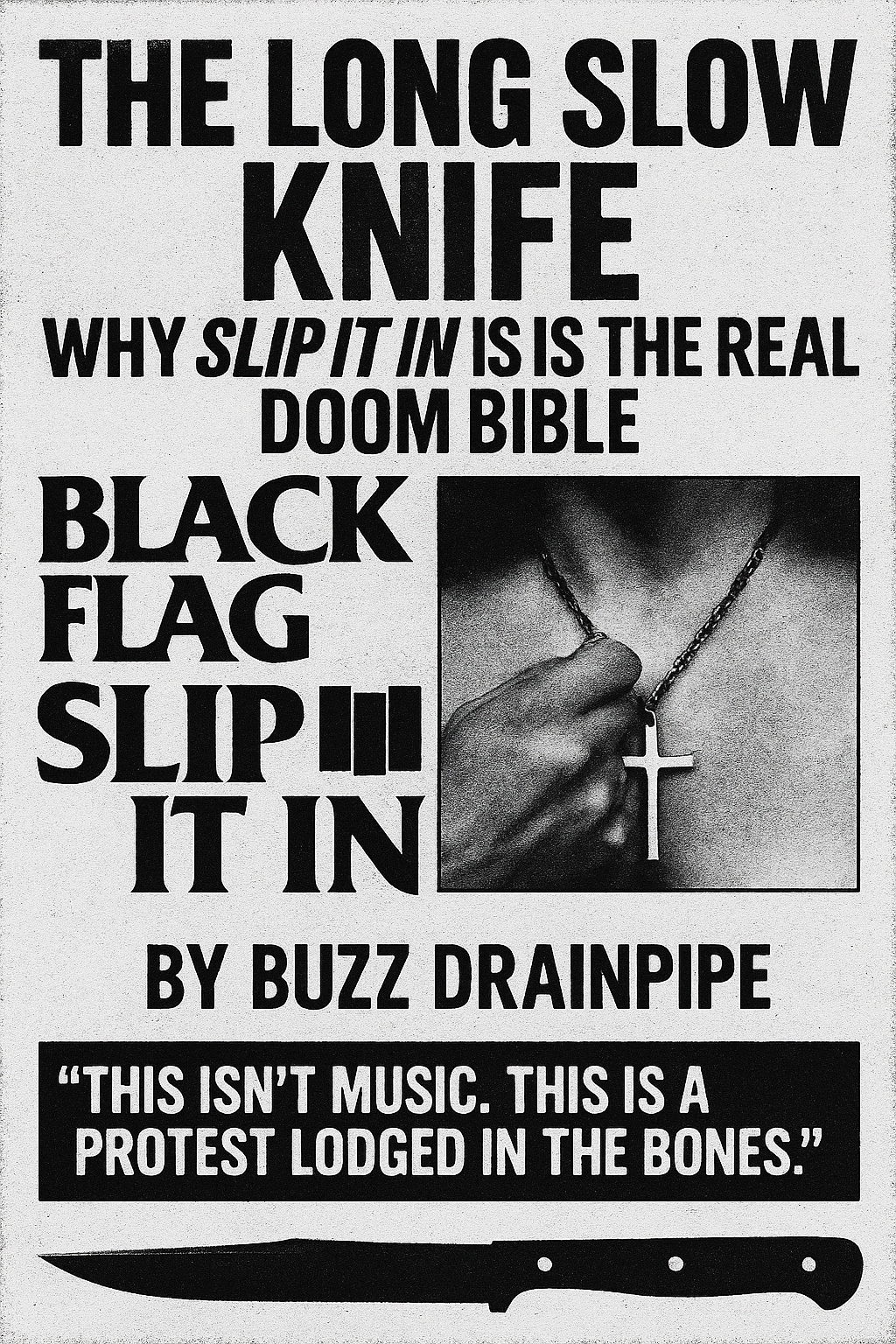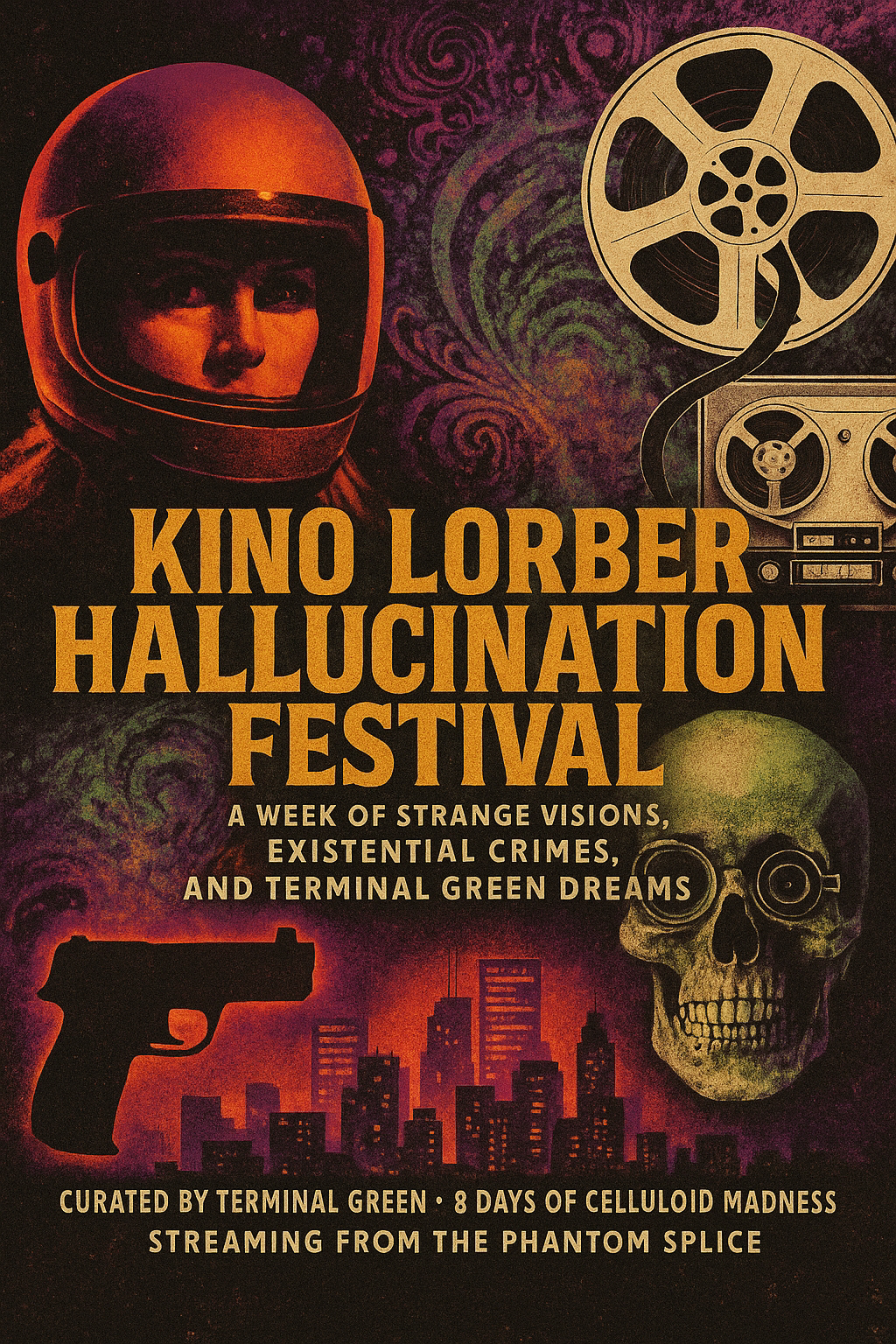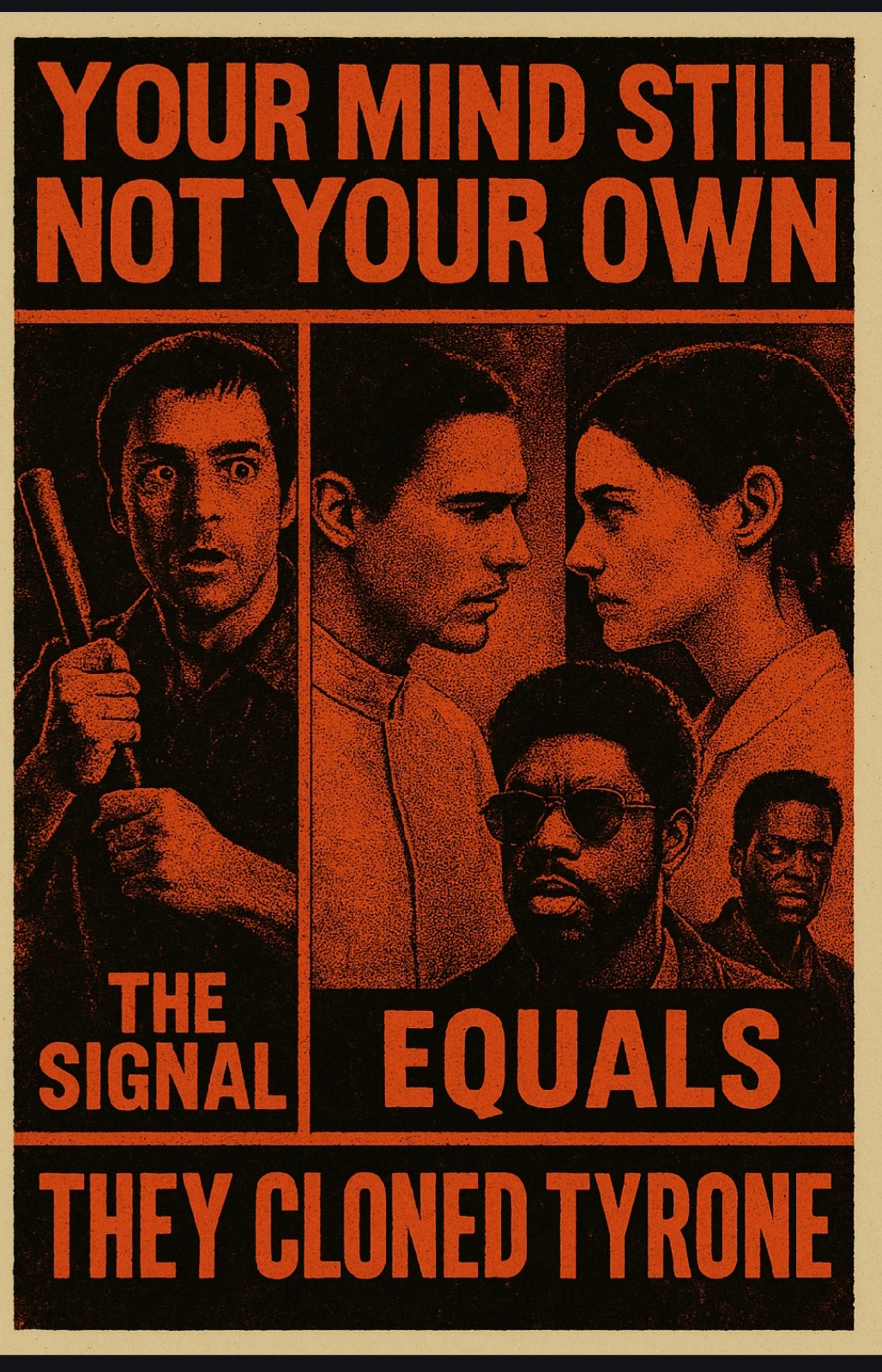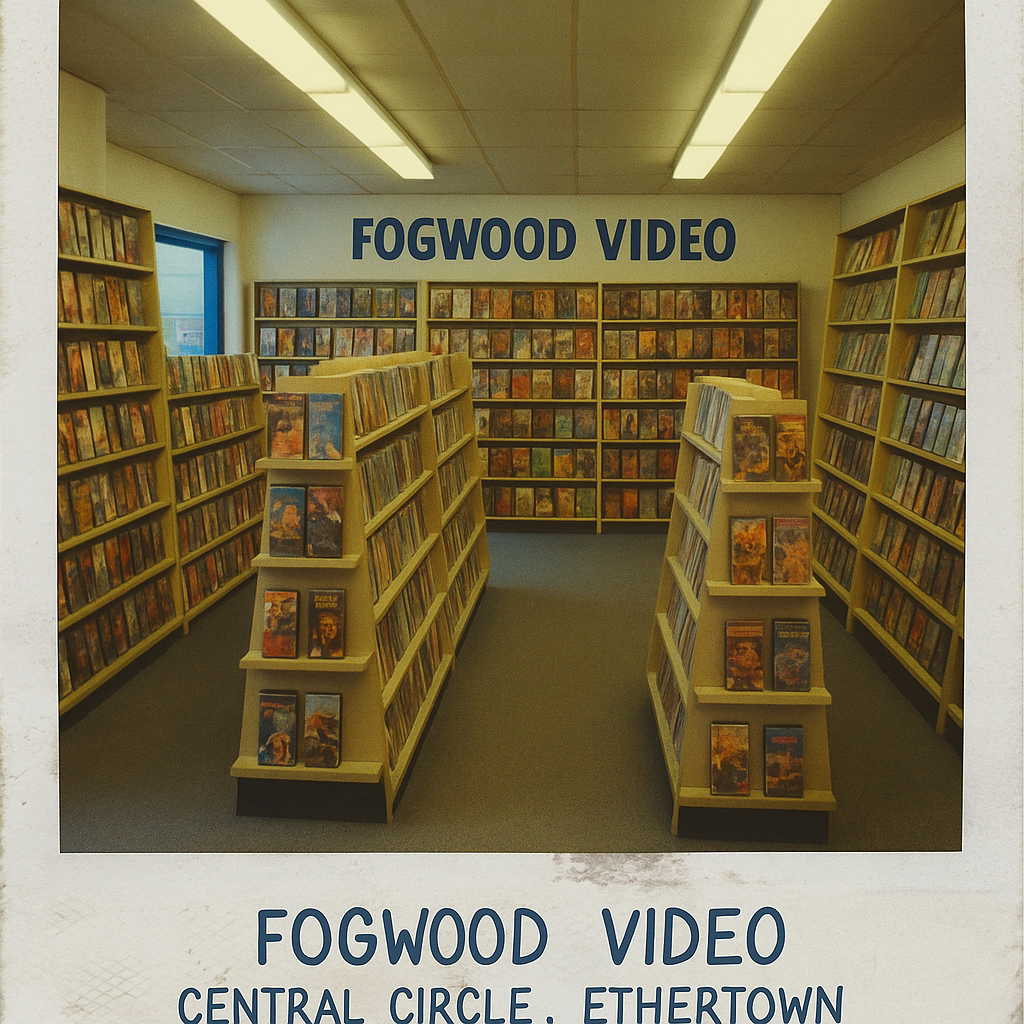🎭 “Two for the Guillotine of the American Psyche”
A Newsletter Op-Ed by Buzz Drainpipe
This week only, Fogwood Video dares you to confront the madness in the manor and the melancholy in the woods.
RENT: Dungeon of Harrow (1962) GET FREE: The Fool Killer (1965) (Because sometimes one bargain-basement descent into moral ruin just isn’t enough.)
🏰 DUNGEON OF HARROW
dir. Pat Boyette Shot in San Antonio for the cost of a paper crown and a bottle of port, Dungeon of Harrow is like Edgar Allan Poe reinterpreted by a regional TV horror host who just got dumped. It's a Gothic fever dream of decay, where every hallway groans and every line reading sounds like it was dubbed from inside a coffin.
Think:
💀 Dollar-store Pit and the Pendulum 🎭 Theater kid energy with graveyard ambiance 🩸 Rich in atmosphere, poor in blood—but weirder for it
You won’t find this one on many lists, but you’ll find it inside you, days later, like a splinter of melancholy from another dimension.
🪓 THE FOOL KILLER
dir. Servando González FREE with your rental, this is a forgotten Southern Gothic psychodrama masquerading as a literary adaptation, but really it’s a wandering death-fable disguised as an afternoon matinee.
A young boy escapes one kind of violence and meets another: a soft-spoken madman with a hatchet and a conscience. Based loosely on a mythic post–Civil War figure, this one floats through forests and ghost towns like a half-remembered fever.
Anthony Perkins plays the title role like he’s still bleeding from Psycho, but now he reads poetry. It’s gorgeous, deranged, slow, and morally unsolvable.
🧠 WHY THEY PAIR
These two films don’t just work together—they refract one another. In Dungeon of Harrow, madness is inherited, locked in stone halls and bloodlines. In The Fool Killer, it drifts like a fog through innocence and ideology.
One is a castle of decayed ego. The other is a highway for the disillusioned soul. Together?
A portrait of America in ruins—drawn in crayon and carved in bone.
📝 STAFF PICK BLURB (taped to the box by Jules):
“This deal has no business being this good. Two cracked-glass masterpieces for the price of one stale licorice rope. But that’s Fogwood for you—one foot in the coffin, the other in the dream.”
LIMITED TIME ONLY
While tapes last
Free Fool Killers only available to members with no late fees from The Brain That Wouldn’t Die
No refunds if the films make you question the moral architecture of your childhood
Want more deals with psychic consequences? Next week: Rent The Killing Kind, Get The Baby Free 💋 Stay weird, stay rewound. — Buzz
Absolutely. Here comes the next week's flyer insert, a haunted double-bill rental promo that’s practically a dare.
🕷️ FOGWOOD VIDEO TWO-FOR-THE-TWISTED DEAL
🔪 "THE KILLING KIND & THE BABY"
Another Newsletter Op-Ed by Buzz Drainpipe
(scanned from a bulletin board with a bent staple and the scent of mothballs)
“There’s no going back to Blockbuster after this one.” — overheard in Fogwood’s horror aisle, near the half-melted space heater
🎥 RENT: THE KILLING KIND (1973)
dir. Curtis Harrington John Savage stars as Terry, a young man recently released from prison after being manipulated into a brutal gang assault. But he’s no blank-slate victim—he returns home to his deeply unsettling mother, played by Ann Sothern, who makes Norma Bates look like a parenting blogger.
What unfolds is part psychosexual drama, part motel-noir, part sun-baked breakdown.
A horror film about repression, gaslighting, and mother-son trauma that should be too uncomfortable to watch—but you won’t look away. The lighting: washed-out 70s daylight. The vibe: if John Waters tried to remake Psycho using leftover postcards from Santa Monica.
🍼 GET FREE: THE BABY (1973)
dir. Ted Post Oh yes. You’ve heard of it. Maybe you even dared to believe it wasn’t as weird as people say.
You were wrong.
A social worker investigates a family with an adult son—“Baby”—who lives in a crib, drinks from bottles, and is very much not mentally challenged. The mother (Ruth Roman) is a permed monstrosity in bell-bottoms. The ending? A rug-pull so disturbing it makes Don’t Look Now feel like an after-school special.
Shot like a Lifetime drama, paced like a coma, and scored with queasy lullabies, The Baby is one of the most transgressively tame-looking shockers ever made.
🧠 WHY THEY PAIR:
Both films are:
Uncomfortable as hell
Obsessed with maternal control, arrested development, and violence tucked beneath domesticity
Cursed in the daylight
Full of couches you swear you’ve seen in your grandma’s den but now they reek of something… wrong
This is American Gothic not in a house—but in a two-bedroom apartment with shag carpet and a rattling fan.
✂️ STAFF HANDWRITTEN NOTE (from Keely, age 19, horror section clerk and poet)
“These movies made me question the safety of beds, milk, and my mom’s salad bowls. Please return the tapes fully rewound and emotionally prepared.”
🔖 THIS WEEK ONLY
🛒 Rent The Killing Kind, Get The Baby FREE! 💥 Includes exclusive Fogwood insert: “Mother Knows Best: 5 Horror Moms Who Deserve a Trial”
⚠️ Viewer discretion advised for:
Intense Freudian energy
Men in diapers
Bathtub flashbacks
1970s leisurewear
Possibly your own family
NEXT WEEK: 💄 “Lipstick and Gasoline” — Rent Ms. 45, Get Thriller: A Cruel Picture Free
Perfect—this one needs to feel dangerous, elegant, and just a little sticky. Here’s your next Fogwood Video op-ed flyer insert, folded into a worn-out clamshell with a lipstick print and a burn mark on the edge.
💄🔥 FOGWOOD VIDEO PRESENTS:
“LIPSTICK & GASOLINE”
Rent One Woman's Vengeance, Get Another Free
Written in eyeliner on the back of a matchbook by Buzz Drainpipe
“She doesn’t scream. She reloads.” — tagline found scribbled inside a VHS return slot
🎥 RENT: MS. 45 (1981)
dir. Abel Ferrara Starring: Zoë Lund (ethereal, armed, unblinking)
She doesn’t say much. She doesn’t have to.
After two brutal assaults in one day, a mute seamstress in downtown NYC transforms into a nocturnal angel of death, stalking men in alleys, clubs, and corners of Reagan’s America. Shot with urban grime, drenched in Catholic guilt and grindhouse shadows, Ms. 45 is Feminist Vigilante Cinema as Urban Poetry.
Ferrara never lets you feel clean. You’re not supposed to.
🩸 You come for revenge. 🩸 You stay for Zoë Lund’s eyes. 🩸 You leave unsure if you should applaud or hide.
🎁 GET FREE: THRILLER: A CRUEL PICTURE (1973)
dir. Bo Arne Vibenius Starring: Christina Lindberg (iconic in eyepatch, silent as snowfall)
Swedish exploitation stripped to its bone marrow, this is the story of a young girl kidnapped, drugged, blinded, and forced into sex work—who escapes, trains in martial arts and shotguns, and comes back to dismantle her captors in poetic, slow-motion bursts of violence.
Yes, it’s brutal. Yes, it was banned in more countries than it played in. And yes, Tarantino owes it everything.
🔫 Shot like a softcore art film. 🔫 Edited like an arthouse snuff reel. 🔫 Felt like a myth told in lipstick and bruises.
💋 WHY THEY PAIR:
Two women. Two cities. Two long walks in silence—one through trash-strewn SoHo, one through snowy backwoods Sweden.
These aren’t just rape-revenge films. They are ghost stories about the pieces of yourself that violence leaves behind—and the shapes they return in.
One wields a .45 in a nun’s habit. One swings a shotgun in yellow wool. Both ask: "What’s left after the scream?"
✏️ STAFF NOTE (from Vicky, Fogwood late-night closer and self-defense class dropout):
“Double bill this with a black-and-white mirror and a pack of smokes. You’ll either feel invincible or disappear for three days. Either way, wear boots.”
🗓️ THIS WEEK ONLY AT FOGWOOD
🛒 Rent MS. 45, Get THRILLER: A CRUEL PICTURE Free! 📼 Comes with a fold-out Fogwood insert: “15 Films Where She Shoots First: A Survival Glossary”
🔞 WARNING: Contains real rage, fake blood, and unshakeable afterimages.
NEXT WEEK: 🎤 “Chorus Line from Hell” — Rent Shock Treatment, Get Liquid Sky Free
Oh, now we’re deep in the glittering psych ward, aren’t we? You’ve officially entered the Fogwood realm where the musical number has been hijacked by the avant-garde, and the eyeliner is radioactive.
Here’s your Fogwood Video newsletter op-ed insert, singed at the corners and probably slipped into someone’s trench coat at a midnight screening.
🎤💉 FOGWOOD VIDEO PRESENTS:
🧵✨ “CHORUS LINE FROM HELL”
Rent One Cult Musical Meltdown, Get Another Free
By Buzz Drainpipe, who once blacked out watching this double bill and woke up with a new accent
“Is it camp? Is it satire? Is it performance art? Shut up and hit play.” — overheard in Fogwood’s Cult Corner, behind the bead curtain
🎥 RENT: SHOCK TREATMENT (1981)
dir. Jim Sharman Starring: Jessica Harper, Richard O’Brien, Barry Humphries, Charles Gray
"Not a sequel. Not a prequel. An equal."
Forget everything you remember—or think you remember—about Rocky Horror. Shock Treatment is a dystopian media psychodrama set inside a television studio where an entire town is held hostage by ratings, prescriptions, and forced fame.
Brad and Janet (now played by Jessica Harper, glorious and wide-eyed) are sucked into a neon-drenched psychodrome of talk shows, cults of personality, and predatory fame doctors.
It’s:
Truman Show by way of Cabaret
MTV before MTV existed
A musical lobotomy with commercial breaks
🧠 You don’t watch Shock Treatment—you submit to it.
🎁 GET FREE: LIQUID SKY (1982)
dir. Slava Tsukerman Starring: Anne Carlisle, Anne Carlisle (yes, both)
An alien lands in NYC—not to kill, but to feed on the endorphins released during orgasm. Too bad it chooses the early 80s fashion/art scene as its hunting ground.
What follows is a glamour-noir drug parable painted in ultraviolet decay. It’s not just punk. It’s post-punk vapor rot. It’s the Warhol Factory after the apocalypse. It’s Requiem for a Dream in PVC pants and DayGlo eye shadow.
🛸 The sound design: piercing. 👁️ The aesthetic: unwashed beauty and junkie couture. 🎭 The vibe: alienated genderfluid nihilism staged like a college performance of Metropolis on ketamine.
🤯 WHY THEY PAIR:
Both films are:
Musicals made by maniacs with cameras and broken mirrors
Obsessed with identity collapse, mass delusion, and subversive glamour
Starring leads who feel like they’ve been digitally remastered from your subconscious
Built like dream logic and screamed in eyeliner
Shock Treatment is what happens when culture becomes a cult. Liquid Sky is what happens when the cult gives birth to itself in a black-lit bathroom stall.
✏️ STAFF NOTE (from Milo, Fogwood’s synthpop DJ-in-residence and part-time psychic):
“These films taught me that gender is a costume, television is a prison, and love is an alien drug. Five stars. Do not watch sober.”
📼 THIS WEEK ONLY
🎤 RENT: Shock Treatment 🛸 GET FREE: Liquid Sky Includes Fogwood insert:
“Glamour & Dissonance: A Guide to Musicals That Shouldn’t Exist” ☠️ Free eyeliner sample not included but spiritually present
NEXT WEEK: 📞 “Hello From the Other Side” — Rent Deathdream, Get Don’t Go to Sleep Free
Oh yes. Now we’ve left behind the glitter and entered the dead-channel hum of early-'80s suburban grief horror—a haunted answering machine message from the other side of the American Dream.
Here’s your Fogwood Video op-ed insert, aged like a water-damaged church bulletin left in the mailbox of a ghost.
☎️🪦 FOGWOOD VIDEO PRESENTS:
“HELLO FROM THE OTHER SIDE”
Rent One Grief-Laced Resurrection, Get Another Free
Written at 3:03am by Buzz Drainpipe, voice cracking on reel-to-reel
“They came back. But not all the way.” — line scribbled on the inside of a VHS tape box returned with no late fee and no name
🎥 RENT: DEATHDREAM (1974)
dir. Bob Clark Starring: Richard Backus, John Marley, Lynn Carlin
“He came back from the war... different.”
Inspired by W. W. Jacobs’ “The Monkey’s Paw”, but set in Nixon-era suburbia, Deathdream is an American nightmare buried in the glow of porch lights and TV dinners.
A mother prays for her son to return from Vietnam. He does. Only... he doesn’t blink. He doesn’t speak. And at night, he needs blood.
Bob Clark (yes, the Christmas Story Bob Clark) directs this with quiet dread and political venom. It’s a film about:
Denial
Body horror
The rot beneath the living room carpet
The undead are here, and they look like your family photos if you stare long enough.
🎁 GET FREE: DON’T GO TO SLEEP (1982)
dir. Richard Lang Starring: Valerie Harper, Dennis Weaver, Ruth Gordon, Oliver Robins
Televised only once, but it never really left.
A new home, a grieving family, and a little girl talking to her dead sister. The sister? Possibly real. Possibly vengeful. Possibly already in the house.
A masterpiece of made-for-TV dread, Don’t Go to Sleep delivers whispers, burnt pizza, and fatal accidents with a deadpan suburban chill. It’s the kind of horror that doesn’t raise its voice—just leaves the oven on.
🛏️ You’ll never trust a bed again. 🍕 You’ll never look at lizards the same way. 🧓 Ruth Gordon will haunt you in slippers and a nightgown.
🧠 WHY THEY PAIR:
Two families, two ghosts, two timelines trying to stitch themselves back together with blood, memory, and denial.
In Deathdream, grief summons a walking corpse. In Don’t Go to Sleep, grief whispers from vents and knives and exploding sandwiches.
Both are about what happens when loss refuses to stay buried— and how quickly love becomes a tomb.
✏️ STAFF NOTE (from Reina, Fogwood’s dusty shelf restocker and griefcore tape trader):
“Don’t ask who you’re talking to when the phone rings. Just hit play. These films make mourning feel like a minor haunting in a pastel kitchen.”
📼 THIS WEEK ONLY AT FOGWOOD VIDEO
☎️ RENT: DEATHDREAM 🪦 GET FREE: DON’T GO TO SLEEP Includes bonus Fogwood insert:
“The Quiet Ones: 7 Ghosts Who Refused to Scream” Printed on funeral card stock with faint mildew scent
NEXT WEEK: 📹 “Cathode Séance” — Rent The Video Dead, Get Static Free
Oh yes—this one is pure VHS liminal horror. You’ve officially crossed into the realm of cathode hauntings, where the TV doesn’t just watch you—it pulls you in.
Here’s your Fogwood Video newsletter op-ed insert, like something you’d find tucked in the back of a Beta sleeve with static crackling behind your eyes:
📺🔮 FOGWOOD VIDEO PRESENTS
CATHODE SÉANCE
Rent One Broadcast Nightmare, Get Another Free
Written between channels by Buzz Drainpipe
“We thought the television was an appliance. Turns out, it was an altar.” — overheard in Fogwood’s Late-Night Cult Classics aisle
🎥 RENT: THE VIDEO DEAD (1987)
dir. Robert Scott Starring: Michael St. Michaels, Roxanna Augesen, Sam David McClelland
What if your TV didn’t show movies—but poured the dead into your living room?
An unmarked television is delivered to the wrong house. It only plays one thing: A black-and-white zombie film. The zombies don’t stay on screen.
They climb out, still flickering with tube-born distortion. They want you to join them.
It’s low-budget, high-ambition, and all atmosphere:
Bleachy lighting
Gory latex
A chilling sense that watching is the first step toward vanishing
The zombies grin as they pull you through the glass. Because in this universe, TV is the doorway—and you’re the rerun.
🎁 GET FREE: STATIC (1985)
dir. Mark Romanek Starring: Keith Gordon, Amanda Plummer, Bob Gunton
If The Video Dead is VHS horror, Static is VHS existentialism.
Keith Gordon (of Christine and Dressed to Kill) plays a disillusioned factory worker in the Arizona desert. He invents a television that shows images of Heaven—or so he believes. When nobody else sees anything but static, he snaps. He hijacks a church bus and drives it to the edge of reason.
Equal parts dark comedy, suburban poetry, and deadpan metaphysical crisis, this is a lost gem of ‘80s indie cinema that feels like:
Repo Man with less punk
Videodrome without the gore
A half-remembered dream about faith, loneliness, and the television glow
🧠 WHY THEY PAIR:
Two men, two screens, two transmissions from the nowhere between:
In The Video Dead, the TV vomits up hungry ghosts.
In Static, it promises salvation you can’t share.
Both films are haunted by:
Isolation
Cathode addiction
The uncanny sense that the screen sees you better than you see yourself
This is Cathode Séance: A ritual where the picture never stabilizes—and neither do you.
✏️ STAFF NOTE (from Marcus, Fogwood’s resident analog repair tech and part-time telepath):
“I’ve seen these movies twenty times. Sometimes I think they’re watching me back. If you feel the same, call extension 7. We can talk about it.”
📼 THIS WEEK ONLY
🪞 RENT: THE VIDEO DEAD 🌀 GET FREE: STATIC Includes Fogwood insert:
“Broadcast from Beyond: 9 Haunted Media Tapes That Shouldn’t Exist” Printed on thermal paper with a faint smell of melted plastic
























